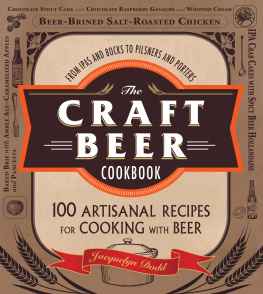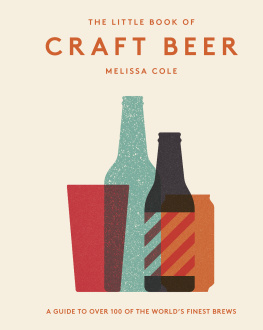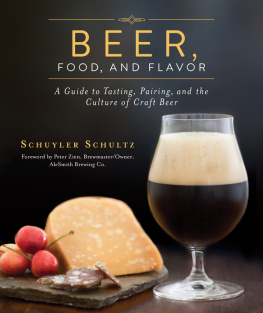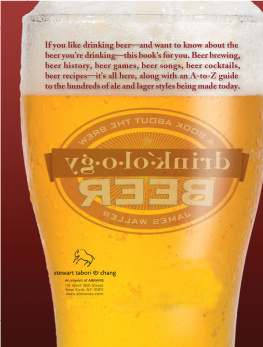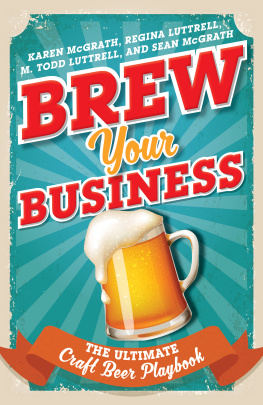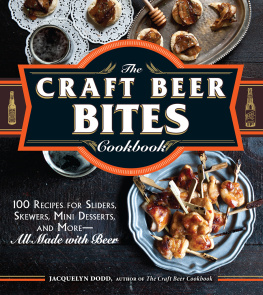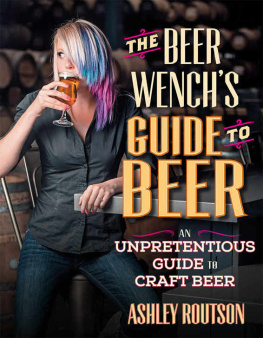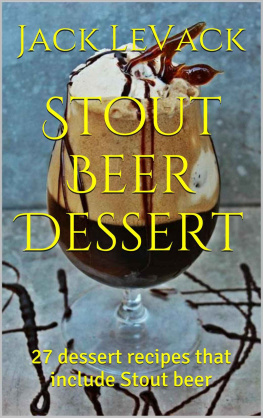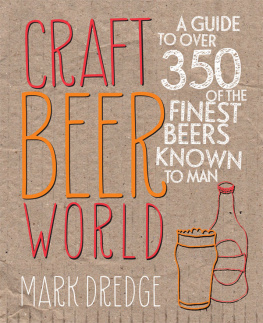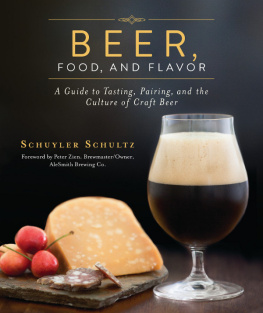FROM IPAS AND BOCKS TO PILSNERS AND PORTERS
The Craft Beer
Cookbook
100 ARTISANAL RECIPES
FOR COOKING WITH BEER
Jacquelyn Dodd

Avon, Massachusetts

Dedication
To Chris,
For truly seeing me before
I could ever see myself.

INTRODUCTION
Over the past decade there has been an explosion of well-made beer in the United States, a phenomenon we like to call the Craft Beer Movement. From home brewers to craft breweries, the United States is setting new records for beer production each year, with nearly 3,000 craft breweries. But what is craft beer? The definition is a bit wily and hard to pin down. The answer, more or less, is thoughtfully made beer using premium ingredientsbeer made with a focus on quality over quantity and taste over profit. The enthusiasm these brewers have for their creations is infectious, erasing all stereotypes of a beer scene centered around keg stands, beer pong, and cold pizza. The craft beer movement is about taste, quality ingredients, years of shaping the perfect stout, the fine balance between hops and malt, and the resulting masterpiece. The first head brewer I ever met summed it up this way: Good beer makes you think.
Cooking with beer isnt just a novelty; beer has exceptional powers in the kitchen. This book is filled with recipes that highlight the three main reasons to cook with beer: leavening, tenderizing, and taste.
Leavening is an incredible example of why beer is a fantastic baking ingredient. Because beer is brewed with so many of the same ingredients used to make breads, its an excellent choice when baking. Beer is also a powerful meat tenderizer, giving even the toughest cuts of meat a texture makeover. And beer can lend its fantastic flavors to almost every kind of food there is. Once you pop a pint into that stew pot, you may never cook in a sober kitchen again.
Over the years of running a website centered on cooking with beer, TheBeeroness.com, Ive become acquainted with beer of every type and how to integrate it into food. Ive learned the perils of trying to reduce an IPA as well as the joys of baking a malty stout cake. This book draws on the lessons Ive learned to find the perfect balance of beer flavor as well as the key to heighten beers leavening and tenderizing properties. If youre new to beer, the Beer 101 section gives you a brief overview of the main beer styles so that you can get more familiar with the language. In the Cooking with Beer section, you will learn how to choose the right beer for cooking, how to amend your favorite existing recipes to include beer, and how to increase or decrease the level of beer flavor in your final results. For each recipe Ive included Choose the Right Brew! sidebars to help you find the beer that goes best with each dish. So pour yourself a pint, grab a whisk, and lets get started!
BEER 101: BEER STYLE BASICS
Heres a very quick and dirty intro to the most common styles of beer. This is not meant to be comprehensive, just a mere introduction; many great beer styles were not included. At the very top of the beer family tree, there are two main types of beer from which each style of beer descends: ales and lagers. Craft beer, like most great art, has begun to blur the lines of those two styles to produce hybrids. For our purposes, however, all beers are either one or the other. The difference, more or less, lies in the yeast.
Ales
Although its nearly impossible to pinpoint an actual beer birthday, ales came first and are thought to have graced the world with fermented goodness for as long as 9,000 years. Ales are whats known as top fermented, which means the yeast rises to the top as the beer is created. Ales are fermented at higher temperatures and are commonly thought of as more full-bodied and more complex than lagers.
PALE ALES
Pale ales get their name from the pale malt used to make them, but they can range in color from a very light yellow to amber. Typically, a pale ale has an evenly balanced malt-to-hop ratio, so although the hop flavor is present, its more subtle.
With that in mind, American pale ales, also known as American IPAs or American Indian pale ales, arent shy with the hops. American brewers love their hopsin fact, the more the merrierand they arent afraid to add a double or even a triple dose for your drinking pleasure. The more the merrier is how America views its unabashed love of all things hops and in beers equivalent of an arms race, theyre in to create the hoppiest beer ever invented. If you grab yourself an American pale ale, brace yourself for a mouthful of hop flavor.
English Indian pale ales, or IPAs, while still hop-forward in taste, are more balanced than the American IPAs and tend to have an earthier, spicier quality. England is actually credited with the invention of the IPA, although beer geeks debate why. Some are quick to tell you that the IPA was invented out of necessity; the higher level of hops and alcohol allowed the beer to make the long voyage from England to India without spoiling. Others will argue that English brewers believed that hops were a necessity in warm climates. Either way, I love to sit back and watch a good, well-educated, beer debate. Pass me an IPA and Ill enjoy the show.
BROWN ALES
While the IPA is all about the hops, brown ales favor the malt. Brown ales range in color from amber to a rich chocolate and often lean toward flavors of nuts, caramel, and even fruit. Although brown ale is traditionally a low-hop beer, American brewers have often had their hoppy way with this style, and the traditional profile of the beer has changed in recent years. If a beer is labeled American Brown Ale, count on more hops. If its an English Brown Ale, bet on a sweeter, maltier flavor.
PORTERS AND STOUTS
These are the dark knights of the beer world. Although the difference between the two is becoming increasingly blurred as the creativity and ingenuity of brewers continues to muddy the definitions of beer styles, there are a few things that most craft beer aficionados agree upon. First, stouts tend to use roasted barley, while porters generally dont. Second, porters tend to be a bit hoppier than stouts. Third, porters came first. The stout porter, later shortened to just stout, was conceived later, when someone decided to start tinkering with the porters ABV (Alcohol by Volume, a standard measure of the alcohol content of a beverage). Finally, while there will always be argument over proper classification, someone will always be around to enjoy a pint!
WHEAT ALES
We give Germany the credit for these brews, which can range in color from very pale yellow to orange. Wheat beers are brewed with wheat and tend to have a yeast-forward taste and traditionally a lower hop profile. These beers often have flavor notes of banana, cloves, yeast, bread, and even bubble gum. The most common types of wheat beers are the popular hefeweizen and the Belgian white ale. Although some wheat beers can be bottom-fermented lagers, wheat beers are most commonly top-fermented ales.

